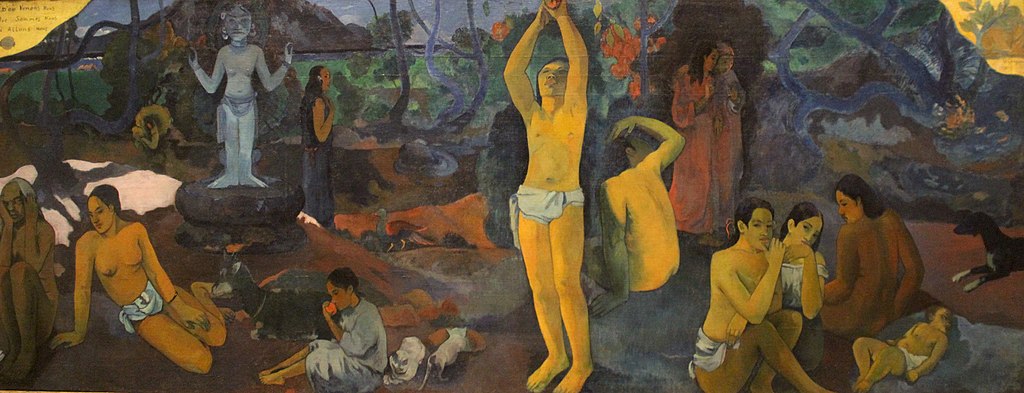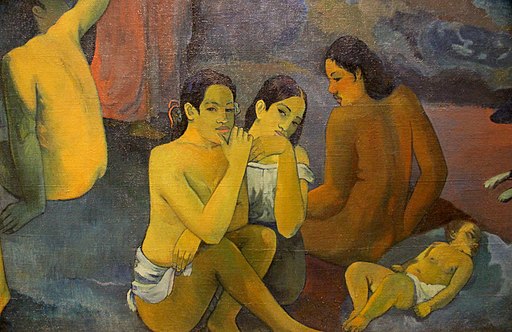
“Where Do We Come From? What Are We? Where Are We Going?” by Paul Gauguin depicts three major figure groups illustrating the questions posed in the title of this composition.
Gauguin felt strongly about this painting; he stated:
“I believe that this canvas not only surpasses all my preceding ones but that I shall never do anything better—or even like it.”
Staring with the group on the right, the three women with a child represent the beginning of life. The middle group symbolizes the daily existence of young and adulthood.

“Where Do We Come From?
In the final group, on the left, according to the artist:
“an old woman approaching death appears reconciled and resigned to her thoughts.”
At her feet, the white bird represents the uselessness of vain words. The blue idol in the background represents what Gauguin described as “the Beyond.”
Gauguin’s post-impressionistic style is defined by the vivid use of colors and thick brushstrokes. It is impressionists with the focus on quick brushstrokes, but it aimed to convey an emotional vision.
Gauguin’s inscription on the top left corner of the canvas gives the painting its title, but it has no question mark, no dash, and all words are capitalized. In the upper right, he signed and dated the painting: P. Gauguin / 1897.

Where Are We Going?
Gauguin painted this canvas in Tahiti, where he went looking for a society more simple and more elemental than that of his native France. He left for Tahiti in 1891, and he painted several paintings that express his highly individualistic mythology.
Paul Gauguin was in despair when he undertook the painting, mourning his favorite daughter’s death earlier that year. He was oppressed by debts and had planned to kill himself on finishing this painting.
He subsequently made an unsuccessful attempt with an overdose of arsenic.
Later, Gauguin wrote a detailed description of the work concluding with the remark that:
“Seeing they see not, hearing they hear not.”
Paul Gauguin
Paul Gauguin (1848 – 1903) was a French post-Impressionist artist who was not appreciated until after his death.
Gauguin is now recognized for his experimental use of color and the Synthetist style distinctly different from Impressionism.
He spent the last ten years of his life in French Polynesia, and most of his paintings from this time depict people or landscapes from that region.
His work was influential to the French avant-garde and many modern artists, such as Pablo Picasso and Henri Matisse. Gauguin’s art became famous after his death.
Gauguin was an essential figure in the Symbolist movement as a painter, sculptor, printmaker, ceramist, and writer.
Where Do We Come From? What Are We? Where Are We Going?
- Title: Where Do We Come From? What Are We? Where Are We Going?
- French: D’où venons-nous ? Que sommes-nous ? Où allons-nous ?
- Artist: Paul Gauguin
- Year: 1897
- Medium: oil on canvas
- Dimensions: Height: 139.1 cm (54.7 in); Width: 374.6 cm (12.2 ft)
- Museum: Museum of Fine Arts, Boston
Paul Gauguin “Where Do We Come From? What Are We? Where Are We Going?”
Paul Gauguin
- Artist: Paul Gauguin
- Birth Name: Eugène Henri Paul Gauguin
- Born: 1848, Paris, France
- Died: 1903 (aged 54), Atuona, Marquesas Islands, French Polynesia
- Nationality: French
- Movement: Impressionism, Post-Impressionism, Primitivism
- Notable works:
- Vision after the Sermon
- Where Do We Come From? What Are We? Where Are We Going?
- Self Portraits by Paul Gauguin
- Gauguin in front of his easel
- Portrait of the Artist with the Yellow Christ
- Tahitian Women
- The Dream – Courtauld Institute of Art
- Not to work – Pushkin Museum of Fine Arts
- Three Tahitians – Scottish National Gallery
- Three Tahitian Women Against a Yellow Background – Hermitage Museum
- And the Gold of their Bodies – Musée d’Orsay
- Barbarian Tales – Museum Folkwang
- The Call – Cleveland Museum of Art
- The Siesta – Metropolitan Museum of Art
- The Moon and the Earth – Museum of Modern Art
- Hail Mary – Metropolitan Museum of Art
- Two Tahitian Women With Mango Flowers – Metropolitan Museum of Art
Where do we come from? What are we? Where are we going? – Paul Gauguin
A Virtual Tour of the Museum of Fine Arts, Boston
- ” Mrs. Fiske Warren and Her Daughter Rachel” by John Singer Sargent
- “Dance at Bougival” by Auguste Renoir
- Relief of a Winged Genie
- “The Fog Warning” by Winslow Homer
- “The Daughters of Edward Darley Boit” by John Singer Sargent
- “Madame Cézanne in a Red Armchair” by Paul Cézanne
- “Appeal to the Great Spirit” by Cyrus Edwin Dallin
- “The Slave Ship” by J. M. W. Turner
- “Poppy Field in a Hollow near Giverny” by Claude Monet
- “Discovery of Achilles on Skyros” by Nicolas Poussin
- Odysseus and Polyphemus” by Arnold Böcklin
- “The Artist in his Studio” by Rembrandt
- Where Do We Come From? What Are We? Where Are We Going? by Paul Gauguin
Gauguin’s Where Do We Come From? What Are We? Where Are We Going?
Where Do We Come From? What Are We? Where Are We Going? by Paul Gauguin
~~~
“I shut my eyes to see.”
– Paul Gauguin
~~~
Photo Credit: Paul Gauguin [Public domain]; Miguel Hermoso Cuesta / CC BY-SA (creativecommons.org/licenses/by-sa/4.0);
Popular this Week








 Sponsor your Favorite Page
Sponsor your Favorite Page SEARCH Search for: Search Follow UsJoin – The JOM Membership Program
Sponsor a Masterpiece with YOUR NAME CHOICE for $5
Share this:
- Tweet
